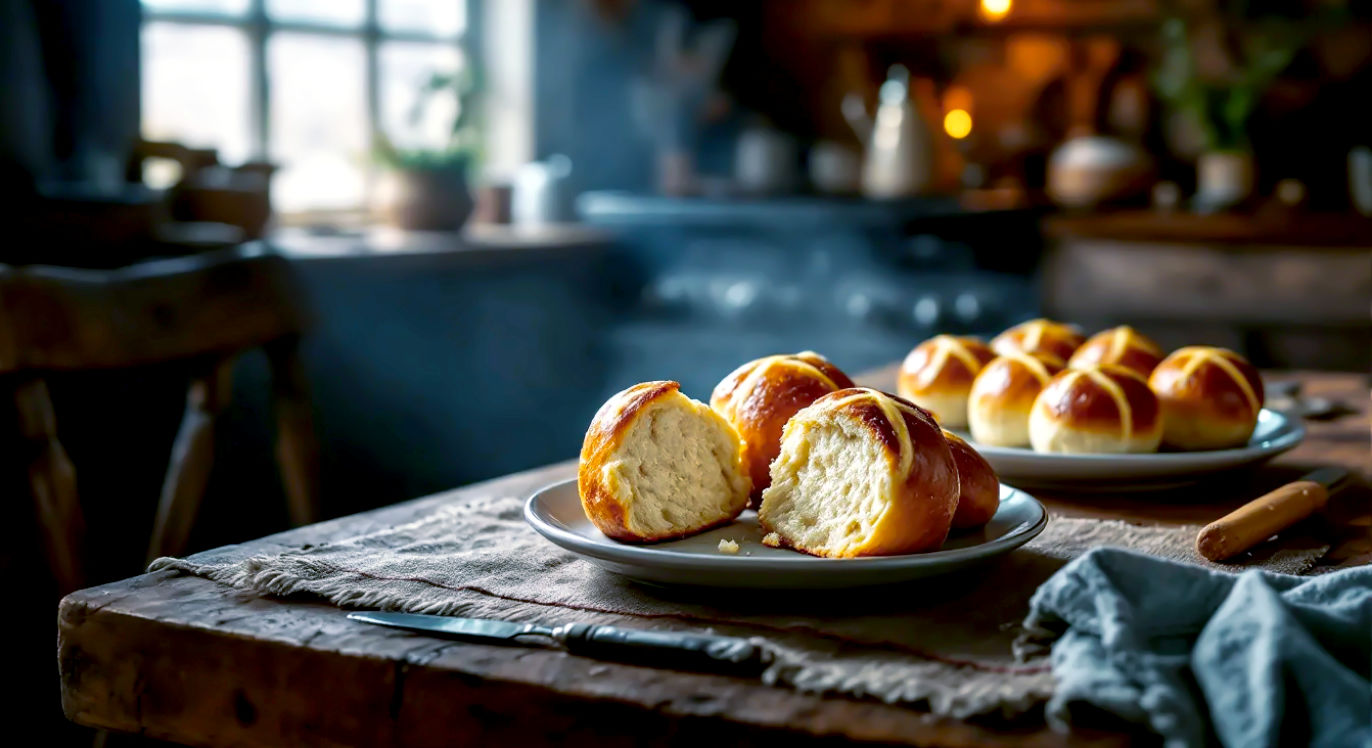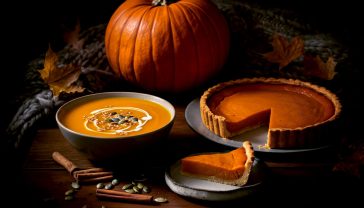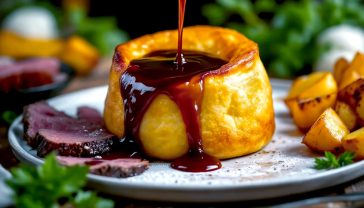The Great British Bun in the Old Dominion: A History of the Hot Cross Bun in Virginia
Explore the rich, untold story of how a classic British Easter treat crossed the Atlantic to become a cherished tradition in colonial Virginia and beyond.

This post may contain affiliate links. If you make a purchase through these links, we may earn a commission at no additional cost to you.
You probably think you know the hot cross bun. It’s that sticky, spicy, fruit-studded treat that turns up in British supermarkets the moment the last Christmas pudding is cleared. It’s the smell of Easter, the taste of a bank holiday weekend, and the subject of a nursery rhyme we all learned before we could properly talk. It’s quintessentially, unshakeably British.
But what if I told you that this humble bun has a hidden history, a secret life played out across an ocean? This isn’t just a story about baking. It’s a tale of faith, folklore, colonisation, and survival. It’s the surprising story of how the hot cross bun left the shores of England and put down deep roots in the rich, complicated soil of Virginia.
Forget everything you think you know. We’re about to follow the scent of cinnamon and nutmeg on a journey from medieval monasteries and London street cries to the grand plantation houses and bustling port cities of America’s Old Dominion. This is the remarkable, untold history of the hot cross bun in Virginia.
From Pagan Rites to Pious Treats: The English Origins of a Famous Bun
Before we can cross the Atlantic, we need to understand where our bun came from. Its story begins long before Christianity, in the mists of Anglo-Saxon England. Pagans celebrating the festival of Eostre, in honour of the goddess of spring and dawn, would bake small cakes marked with a cross. This cross didn’t represent Christ’s crucifixion, but the four phases of the moon or the four seasons, marking the balance of the turning year.
When Christian missionaries arrived, they faced a common problem: how do you get people to give up their old ways? The clever solution was often not to ban traditions but to adopt and reshape them. That pagan bun, with its convenient cross, was ripe for a rebrand. The Church gave it a new, powerful meaning. The cross became the symbol of the Crucifixion. The spices, like cinnamon and nutmeg, were said to represent the costly spices used to embalm Jesus’ body after his death. The bun became a tiny, edible lesson in the Easter story, baked and eaten on the most solemn day of the Christian calendar: Good Friday.
The Monk and the Recipe
The most famous origin story takes us to the year 1361 and the grand St Albans Abbey in Hertfordshire. A monk named Brother Thomas Rocliffe, wanting to do something for the local poor, developed a special recipe for a spiced bun he called the ‘Alban Bun’. He baked them and gave them away to the hungry every Good Friday. The tradition caught on, and St Albans Abbey is still proud of this history, baking buns from a version of the original recipe to this day.
Whether Brother Thomas’s bun was the first hot cross bun is up for debate, but the story shows how the tradition became cemented in English religious life. By the Tudor era, these buns were wrapped up in a fascinating web of superstition and folklore.
A Bun Full of Magic
During the 16th and 17th centuries, people believed that a bun baked on Good Friday had special powers. It was said that a Good Friday bun would never go mouldy. Sailors would take one to sea to protect their ship from sinking. A bun hung in the kitchen rafters was thought to protect the house from fire and ensure every loaf baked that year would be perfect. A small piece grated into a drink could even cure illnesses.
These beliefs were so strong that the buns were seen as a bit too much like magic for the authorities. In 1592, Queen Elizabeth I’s government, tired of potential Catholic symbolism and superstitions, passed a law. The London Clerk of Markets forbade bakers from selling the buns on any day except for Good Friday, Christmas, or at burials. This attempt to clamp down on them only made them more special, cementing their status as a once-a-year treat reserved for the holiest of days. It was this bun—steeped in religion, folklore, and the law—that was packed, in memory and in spirit, into the luggage of the first English settlers bound for America.
Crossing the Pond: A Taste of Home in a New World
In the early 1600s, when the first creaking ships set sail for Virginia, they carried more than just people and provisions. They carried a whole culture in their heads: nursery rhymes, prayers, songs, and recipes. For the English colonists arriving in the unfamiliar, often hostile, landscape of the New World, food was a powerful link to the home they’d left behind. Planting an English garden or baking a familiar loaf of bread was a way of making the strange land feel a little more like home.
Easter, with its promise of rebirth, must have been a hugely significant time for these early Virginians. And what was Easter without the taste and smell of a hot cross bun on Good Friday?
The First Virginian Buns
There are no surviving diaries from a Jamestown settler proudly declaring, “Made a fine batch of cross buns today.” The first buns weren’t sold in bakeries; they were made in the simple, smoky kitchens of colonial homes. The recipe wasn’t written down but passed from mother to daughter, a piece of oral history.
But we know they were there. The tradition was too deeply ingrained in English culture to be left behind. Making these buns was a way of observing Good Friday correctly, of connecting with family back in England, and of asserting their English identity in a foreign land.
Of course, the Virginia bun would have been different from its London cousin. Recipes have to adapt to their surroundings, and colonial Virginia was a world away from Hertfordshire.
- Flour and Yeast: The soft wheat that grew in Virginia’s humid climate produced a different kind of flour than the hard wheat of England. Bakers couldn’t just pop to the shop for yeast; they would have relied on nurtured sourdough starters or the wild yeasts in the air, giving the buns a tangier, less predictable character.
- Spices and Sweeteners: Spices like cinnamon, nutmeg, and cloves were incredibly expensive imports, reliant on precarious shipping routes. A colonial cook might have used them sparingly or substituted them with more readily available allspice from the West Indies. Instead of refined white sugar, many would have used darker, more flavourful molasses or local honey.
- Fruit: Dried currants and raisins, the classic fruit in an English bun, were also costly imports. While wealthier families could afford them, others might have used dried local fruits or omitted them altogether.
The first Virginia hot cross bun was likely a denser, spicier, and less sweet version of the one we know today, a product of ingenuity and necessity.
The Bun in the Big House: A Story of Black and White
By the 18th century, Virginia was a thriving, wealthy colony. Grand plantation houses dotted the landscape, and cities like Williamsburg and Richmond were becoming sophisticated urban centres. It was in the kitchens of these places that the next chapter of the hot cross bun’s story was written—a chapter shaped by the brutal reality of slavery.
The cooks in these grand houses were almost exclusively enslaved African American women. They were highly skilled chefs, responsible for creating elaborate meals that displayed the wealth and status of their enslavers. These women brought their own culinary heritage from West Africa—a tradition rich with spices, slow-cooking techniques, and a deep understanding of flavour.
When the lady of the house requested hot cross buns for Good Friday, it was an enslaved cook who would have been tasked with making them. She would have taken the English recipe and, consciously or not, interpreted it through her own culinary lens. Perhaps she added a little more spice, used a technique for kneading dough learned from her mother, or glazed the buns with something that gave them a deeper, richer colour.
This is a part of the history that is often overlooked. The hot cross bun in Virginia became a food of two cultures. It was an English tradition, maintained by the white planter class as a symbol of their heritage. But it was brought to life by the hands of Black women, who infused it with their own skill and subtle creativity. Finding a specific recipe credited to an enslaved cook from this period is nearly impossible, as their contributions were rarely written down. But their influence is undeniable. They were the master bakers of the Old Dominion, and the hot cross bun was part of their repertoire.
The Famous Street Cry Reaches America
In the growing cities, bakeries began to appear, run by free Black and white tradesmen. And with them came a sound familiar to any Londoner: the street cry. Just as vendors in England chanted, “One a penny, two a penny, hot cross buns!”, vendors in Richmond and Norfolk would have walked the streets on Good Friday morning, selling their fresh-baked wares. Newspaper advertisements from the early 19th century confirm their popularity.
An 1828 ad in the Richmond Enquirer announced that a local baker would have “a supply of hot cross buns, ready for delivery on Good Friday morning.” This shows the bun had moved beyond the home kitchen and was now a commercial product, an expected part of the city’s Easter celebrations.
A Tradition Tested by War and Time
The American Civil War (1861-1865) tore Virginia apart. Blockades and shortages meant that imported goods like sugar, spices, and white flour became luxuries few could afford. For many Virginians, traditions like the hot cross bun would have been an impossible extravagance. People made do with what they had, and festive baking would have been simple and sparse.
But traditions are resilient. After the war, as Virginia slowly began to rebuild, people clung to the customs that gave them a sense of stability and identity. The hot cross bun returned, a symbol of hope and continuity.
The late 19th and early 20th centuries brought huge changes. Industrialisation meant that commercial bakeries could produce goods on a massive scale. The rise of brands like Nabisco and, later, supermarket chains, meant that people could buy standardised, packaged hot cross buns. For many, the homemade tradition began to fade.
The Colonial Revival and a Reborn Bun
Just as the hot cross bun seemed destined to become another mass-produced product, it was given a new lease of life from an unexpected source: nostalgia. The 1920s and 30s saw the beginning of the “Colonial Revival” movement, a surge of interest in America’s early history. This was perfectly captured by the ambitious project to restore Virginia’s colonial capital, creating Colonial Williamsburg.
Historians and food researchers at Colonial Williamsburg began delving into old cookbooks and records to recreate the food of the 18th century. The hot cross bun was a natural fit. They researched old recipes, studied the ingredients that would have been available, and started baking them in the restored Raleigh Tavern Bakery.
Suddenly, the hot cross bun wasn’t just an Easter treat; it was a piece of living history. Tourists flocked to Williamsburg to taste an “authentic” colonial bun. This powerful marketing cemented the hot cross bun’s place in Virginia’s identity, framing it as a treasured link to its colonial past.
The Virginian Bun Today: A Taste of History
So, is a Virginian hot cross bun different from a British one today? The answer is subtle, but yes.
Thanks to the influence of Colonial Williamsburg and the craft bakery movement, there’s a strong emphasis on historical authenticity. Many Virginian bakers who specialise in the buns will use recipes that are a little different from the modern British supermarket version.
- The Spice Mix: They often feature a more complex and aromatic spice blend, sometimes including mace or allspice, reflecting their colonial roots.
- The Texture: The crumb can be slightly heartier, a nod to the less refined flours of the past.
- The Cross: While British buns are now often marked with a simple icing cross, the traditional method—and the one you’ll often find in Virginia—is a cross made from a simple, un-sweetened flour-and-water paste piped on before baking. This creates a satisfyingly chewy contrast to the soft bun.
Today, you can find hot cross buns all over Virginia in the run-up to Easter. From historic bakeries in Williamsburg to trendy cafes in Richmond, the tradition is alive and well. It remains, for the most part, an Easter-specific treat, retaining more of its seasonal specialness than in the UK, where it has become a year-round staple.
A Bun’s Long Journey
The journey of the hot cross bun is a mirror of the journey of Virginia itself. It began as a simple English import, a taste of home carried across the ocean. It was adapted out of necessity, transformed by the skilled hands of enslaved African American cooks, sold on the streets of a bustling new society, and tested by the hardships of war. Finally, it was revived and celebrated as a proud symbol of the state’s long and complex history.
So the next time you bite into a hot cross bun, take a moment. Think of the Anglo-Saxon pagans watching the moon, the medieval monk feeding the poor, the Tudor family hanging a bun in their kitchen for luck, and the colonial Virginian cook adapting an old recipe in a new world. This simple, sticky bun contains multitudes. It’s a taste of history, a symbol of survival, and a delicious reminder that even the most familiar things can have the most extraordinary stories.
Further Reading
For those interested in delving deeper into the history of food and culture in Virginia and beyond, these resources are highly recommended:
- Colonial Williamsburg’s Foodways Program: Explore the history of 18th-century cooking, including seasonal recipes and historical articles from the experts who lead the field in American food history.
- The Virginia Museum of History & Culture: A fantastic resource for understanding the broader context of Virginia’s social and cultural development.
- “High on the Hog: A Culinary Journey from Africa to America” by Jessica B. Harris: A seminal work on the profound influence of African food traditions on American cuisine. While not specific to hot cross buns, it provides essential context for understanding the role of enslaved cooks.
- The British Food History Blog: A wonderful and well-researched blog covering the fascinating stories behind many traditional British foods.






